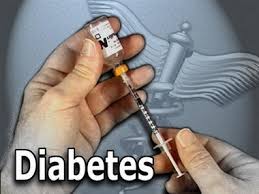Diabetes mellitus
Diabetes mellitus is one of the most common chronic diseases in nearly all countries, and continues to increase in numbers and significance, as changing lifestyles lead to reduced physical activity, and increased obesity (King et al., 1993). Diabetes Mellitus (DM) is now recognized as a global health challenge of the 21st century. On December 20, 2006 the United Nations General Assembly unanimously decided to designate November 14 as the “World Diabetes Day” (UN, 2007). It is a chronic condition in which the body makes no or too little insulin hormone or cannot use it properly. Insulin is produced by the pancreas and helps glucose to enter from the bloodstream into cells wherein glucose is converted into energy. In uncontrolled diabetes, there is an inadequate supply of glucose to the cells and a build-up of glucose in the bloodstream. This can lead to hyperglycemia and a range of disturbances affecting the eyes, heart, brain, kidneys and other parts of the body. In response to this, the body also produces symptoms of polyuria or frequent urination, polyphagia or increased hunger and polydipsia or increased thirst (Hussain 2011).
About 90% – 95% of all diabetes patients of Bangladesh belong to Type 2 diabetes. Onset is often insidious and asymptomatic. Type 2 diabetes is considered as a complex metabolic syndrome. It can lead to both micro and macrovascular complications of DM. It is vital to consider not only the abnormalities of glucose metabolism but also other associated health hazards e.g. obesity, hyperlipidaemia, hypertension, retinopathy, nephropathy, neuropathy, foot ulcer etc (Mahtab et al., 2003).
The World Health Organization (WHO) published estimates for the years 2000 and 2030, using data from 40 countries but extrapolated to the 191 WHO member states (Wild et al., 2004). Diabetes mellitus and its complications contribute significantly to ill health, disability, poor quality of life and premature death. Additionally, diabetes mellitus is a contributing factor to several other causes of morbidity and mortality. It also increases the risk of a variety of complications including end-stage kidney disease, coronary heart disease, stroke and other vascular diseases. According to WHO 346 million people worldwide have diabetes. In 2004, an estimated 3.4 million people died from consequences of high blood sugar. More than 80% of diabetes deaths occur in low- and middle-income countries. WHO projects that diabetes death will double between 2005 and 2030 (WHO 2011)
History of diabetics
Diabetes has been recognized as a devastating and deadly disease for more than 2,000 years. In the first century A.D. a Greek, Aretaeus, described the destructive nature of the affliction which he named “diabetes” from the Greek word for “siphon”. Eugene J. Leopold in his text Aretaeus the Cappodacian describes Aretaeus’ diagnosis: “For fluids do not remain in the body, but use the body only as a channel through which they may flow out. Life lasts only for a time, but not very long. For they urinate with pain and painful is the emaciation. For no essential part of the drink is absorbed by the body while great masses of the flesh are liquefied into urine.” Physicians in ancient times, like Aretaeus, recognized the symptoms of diabetes but were powerless to effectively treat it. Aretaeus recommended oil of roses, dates, raw quinces, and gruel. And as late as the 17th century, doctors prescribed “jelly of viper’s flesh, broken red coral, sweet almonds, and fresh flowers of blind nettles” (Melissa 2008).
Diabetes is one of the first diseases described with an Egyptian manuscript from 1500 BCE mentioning “too great emptying of the urine”. The first described cases are believed to be of type 1 diabetes. Indian physicians around the same time identified the disease and classified it as ‘madhumeha’ or honey urine noting that the urine would attract ants (Leonid 2009). The term “diabetes” or “to pass through” was first used in 230 BCE by the Greek Apollonius of Memphis. Type 1 and type 2 diabetes where identified as separate conditions for the first time by the Indian physicians Sushruta and Charaka in 400-500 AD with type 1 associated with youth and type 2 with being overweight. The term “mellitus” or “from honey” was added by the British scientist John Rolle in the late 1700s to separate the condition from diabetes insipidus which is also associated with frequent urination (Ripoll 2011).
Concerning the sweetness of urine, it is to be noted that the Chinese, Japanese and Korean words for diabetes are based on the same ideographs (糖尿病) which mean “sugar urine disease”. In 1776 that Matthew Dobson confirmed that the sweet taste comes from an excess of a kind of sugar in the urine and blood (Dobson 1776).
CLASSIFICATION OF DIABETES MELLITUS (DM)
The first classification of diabetes mellitus was published by WHO in 1980 (WHO 1980) which, however was later modified in 1985 (WHO 1985). These two classifications of diabetes mellitus and allied categories of glucose intolerance encompassed clinical classes and two statistical risk classes. The WHO Expert Committee on diabetes mellitus in 1980 proposed two major classes of diabetes mellitus termed as IDDM or Type 1 and NIDDM or Type 2. Later in 1985, WHO Study Group on Diabetes Mellitus retained the terminologies IDDM and NIDDM in their report, and introduced Malnutrition Related Diabetes Mellitus (MRDM) as third major type. In both the 1980 and 1985 attempts along with main classes of diabetes other statistical risk group types; Impaired Glucose Tolerance (IGT) as well as Gestational Diabetes Mellitus (GDM) were also included. The 1985 classification, however, was widely accepted and used internationally by the clinicians and scientists. However with increasing knowledge regarding etiological basis and clinical presentation of diabetes an urgent need was felt for an etiological classification to diffuse the confusion in nomenclature of different diabetes class. In the late nineties an Expert Committee on diabetes mellitus by American Diabetic Association (ADA), first proposed a revised classification based on etiological features and subsequently adopted by WHO Study Group on Diabetes Mellitus (Table I) (WHO 1999).
Table : Etiological classification of diabetes mellitus (WHO 1999)
- Type 1 (beta- cell destruction, usually leading to absolute insulin deficiency)
- Type 2 (may range from predominantly insulin resistance with relative insulin deficiency to a predominantly secretory defect with or without insulin resistance).
- Other specific types
(I) Genetic defects of beta- cell function
(II) Genetic defects in insulin action
(III) Diseases of the exocrine pancreas
Fibrocalculus Pancreatic Diabetes (FCPD)
(IV) Endocrinopathies
(V) Drug- or chemical- induced
(VI) Infections
(VII) Uncommon forms of immune- mediated diabetes
(VIII) Other genetic syndromes sometimes associated with diabetes
Gestational diabetes
a. Type 1 diabetes
Type 1 diabetes is sometimes called insulin-dependent, immune-mediated or juvenile-onset Diabetes. It is caused by an auto-immune reaction where the body’s defense system attacks the insulin-producing cells. The reason why this occurs is not fully understood. People with type 1 diabetes produce very little or no insulin. The disease can affect people of any age, but usually occurs in children or young adults. People with this form of diabetes need injections of insulin every day in order to control the levels of glucose in their blood. On average if a mother has the condition, the risk of developing it is about 2%. If a father has the condition, the risk of developing it is about 8%. If both parents have the condition, the risk of developing it is up to 30%. If a brother or sister develops the condition, the risk of developing it is 10 % (rising to 15% for a non-identical twin and 40 % for an identical twin) (UN 2007).
b. Type 2 diabetes
Type 2 diabetes occurs because the body cannot produce enough insulin or because the cells in the body do not react properly to insulin. Earlier it was known as adult-onset or noninsulin-dependent diabetes, is a chronic condition that affects the way in which the body metabolizes sugar (glucose) (Afroza et al., 2011). With type 2 diabetes, the body either resists the effects of insulin or doesn’t produce enough insulin to maintain a normal glucose level. Untreated, type 2 diabetes can be life-threatening (McCulloch et al., 2011). There’s no cure for type 2 diabetes, but it can be managed or even prevented by proper diet, exercising and maintaining a healthy weight. If diet and exercise aren’t enough to control T2DM, then diabetes medications or insulin therapy is needed to manage blood sugar (Bethesda 2011).
Type 2 diabetes usually appears in people over the age of 40, though in South Asian and African-Caribbean people, it often appears after the age of 25. Recently more children are being diagnosed with the condition. Type 2 diabetes is the most common of the two types and accounts for around 90% of people with diabetes (Diabetes in the UK, 2010). If either parent has the condition, the risk of developing it is 15 %. If both parents have the condition, the risk of developing is 75 %. If a non-identical twin has the condition, the risk of developing it is 10 %. If an identical twin has the condition, the risk of developing it is 90 % (Diabetes in the UK, 2010).
Gestational diabetes
Gestational diabetes is a type of diabetes that arises during pregnancy (usually during the second or third trimester). In some women, it occurs because the body cannot produce enough insulin to meet the extra needs of pregnancy. In other women, it may be found during the first trimester of pregnancy, and in these women, the condition most likely existed before the pregnancy (Claire 2008). Gestational diabetes affects up to 5% of all pregnancies (Lancet 2008). Women who are overweight or obese are at a higher risk of gestational diabetes. The lifetime risk of developing T2DM after gestational diabetes is 30% (Girling et al., 2004).
EPIDEMIC AND PREVALENCE OF T2DM IN BANGLADESH
Asia is emerging as the epicenter of diabetes epidemic. Like all other developed and developing countries prevalence and incidence of T2DM are also increasing in Bangladesh. According to the International Diabetes Federation (IDF) Diabetes Atlas, the diabetes cases in Bangladesh may rise upto 7.9 % by the year 2030.
The World Health Organization fact sheet updated in November 2009, estimated that 1.1 million people died from diabetes in the year 2005. According to unpublished finding of Bangladesh Non-Communicable Diseases (NCD) risk factor survey 2010, the prevalence of diabetes was 3.9%. Bangladesh Urban Health Survey 2006 suggests that in urban area the prevalence is just double (10%) the rural area (5%). In 2010, the IDF estimated that 5.7 million (6.1%) and 6.7 million (7.1%) of people living in Bangladesh is suffering from diabetes and impaired glucose tolerance (IGT) respectively. By 2030, that number of diabetic population is expected to rise to 11.1 million. This explosion in diabetes prevalence will place Bangladesh among the top seven countries in terms of the number of people living with diabetes in 2030. According to the latest WHO data published in April 2011 diabetes mellitus deaths in Bangladesh reached 19,598 or 2.05% of total deaths. The death rate is 23.80 per 100,000 of population, which ranked Bangladesh in 109th position in the world (World health rankings, 2010).
In Bangladesh, the percentage of diabetes was 5.2% (rural 4.3%, urban 6.9%) in 1994-95 and increased to 11.2% (urban) and 6.8% (rural) in 2003-04 (Mahbubur et al., 2011). A recent population based study showed a significant increase in the prevalence of DM in rural Bangladesh from 2.3% to 6.8% over 5 years. This prevalence was higher than that found in the previous rural based studies on the same population. Most of these studies have been conducted near the capital city Dhaka and the people of these areas are very much used to modern lifestyle and hence these studies might not reflect the real picture of rural Bangladesh where more than 75% people are living (Afroza 2011).
Table II: Prevalence of diabetes and estimated diabetes numbers among adults aged 20–79 years for the years 2010 and 2030, Among Asian population:(Shaw et al., 2009)
Particularly type 2 diabetes, continues to increase in the US and in all westernized countries. Over the past 40 years, a fivefold increase in the prevalence of type 2 diabetes has been observed in US. Because of the high associated morbidity and mortality, this trend obviously poses a public health threat. Similar trends are observed in developing countries where western lifestyle is adopted. These observations clearly suggest that acquired or environmental factors inherent with western lifestyle play a significant role in the development of type 2 diabetes in a growing number of individuals. An increasing prevalence of diabetes in our population is observed for all ethnic groups. However, Asians Americans have experienced the highest rate of increase in prevalence between the years 1990 and 1998. Among the Asian Americans, immigrants from India, Pakistan, and Bangladesh (South Asians) have the highest predisposition to develop diabetes (Abate et al., 2001).
Pre-diabetes
Prediabetes is a condition in which blood glucose levels are higher than normal but not high enough for a diagnosis of diabetes. This condition is sometimes called impaired fasting glucose (IFG) or impaired glucose tolerance (IGT). People with prediabetes are at increased risk of developing T2DM, formerly called adult-onset diabetes or noninsulin dependent diabetes. Studies have shown that most people with prediabetes develop T2DM within 10 years. People with prediabetes also are at increased risk of developing cardiovascular disease (U.S, 2008).
COMPLICATIONS OF DIABETICS
In common complications of diabetes, increases the risk of heart disease and stroke. 50% of people with diabetes die of cardiovascular disease. Combined with reduced blood flow, neuropathy in the feet increases the chance of foot ulcers and eventual limb amputation. Diabetic retinopathy is an important cause of blindness, and occurs as a result of long-term accumulated damage to the small blood vessels in the retina. After 15 years of diabetes, approximately 2% of people become blind, and about 10% develop severe visual impairment. Diabetes is among the leading causes of kidney failure. 10-20% of people with diabetes die of kidney failure. Diabetic neuropathy is damage to the nerves and affects up to 50% of people with diabetes. Although many different problems can occur as a result of diabetic neuropathy, common symptoms are tingling, pain, numbness, or weakness in the feet and hands (Afroza 2011). These complications are classified into two groups as macrovascular and microvascular.
MACROVASCULAR
Cardiovascular disease
The term cardiovascular disease (CVD) includes heart disease, stroke and all other diseases of the heart and circulation, such as hardening and narrowing of the arteries supplying blood to the legs, which is known as peripheral vascular disease (PVD) (UKPDS Group, 1998). People with diabetes have an increased risk of CVD compared with those without diabetes. The reason is prolonged, poorly controlled blood glucose levels which increases likelihood of furring up of the vessels leading to CVD (Colhoun et al., 2004).
- Cardiovascular disease is a major cause of death and disability in people with diabetes, accounting for 44% of fatalities in people with Type 1 diabetes and 52 % in people with Type 2 (Morrish et al., 2001).
- The cardiovascular risk is the same for people with diabetes as people without diabetes who have had a previous heart attack (Schramm et al., 2008).
- The risk of death from coronary heart disease associated with Type 2 diabetes is about 50 % greater in women than it is in men (Huxley et al., (2006).
- People with T2DM have a two-fold increased risk of stroke within the first five years of diagnosis compared with the general population (Jeerakathil et al., 2007).
Amputation
Foot problems can affect anyone who has diabetes. Diabetes, particularly if poorly controlled, can damage nerves, muscles, sweat glands and circulation in the feet and legs leading to amputations. Reviewing the feet of people with diabetes regularly and keeping blood glucose levels, blood fats and blood pressure under control can prevent some of the complications associated with the feet. Diabetes is the most common cause of lower limb amputations. 100 people a week lose a toe, foot or lower limb due to diabetes. Around one in twenty people with diabetes will develop a foot ulcer in one year. The rate of leg amputations in people with diabetes is over 15 times higher than in people without. Up to 70 % of people die within five years of having an amputation as a result of diabetes (Surahio et al., 2005).
People with diabetes may need emotional or psychological supports. Coming to terms with diagnosis, the development of a complication, the side effects of medication, or dealing with the daily responsibility of self managing diabetes can take their toll on emotional well being. In some cases this can lead to depression, anxiety, eating disorders, or phobias. Several studies suggest that diabetes doubles the risk of depression compared to those without the disorder. Research shows that depression leads to poorer physical and mental function, so a person is less likely to follow a required diet or medication plan (Depression and diabetes, 2002).
Microvascular Complications
Diabetic nephropathy
Kidney disease is much more common in people with diabetes and people with high blood pressure. Diabetes harms the kidney by causing damage to blood vessels in it. Over time, high sugar levels in the blood can cause vessels in kidney to become narrow and clogged. Without enough blood, the kidneys become damaged and albumin passes through these filters and ends up in the urine. If urine stays in the bladder for a long time, it may cause urinary tract infection. This is because of bacteria grows rapidly in urine with a high sugar level. Most often these infections affect the bladder and can sometimes spread to the kidneys (National Kidney Foundation, 2007). Almost one in three people with Type 2 diabetes develops kidney disease (Figure 1).
- Diabetes is the single most common cause of end stage renal disease.
- Kidney disease cause 21% deaths in T1DM and 11% deaths in T2DM (USRDS, 2007).
Diabetic Retinopathy
People with diabetes (both T1DM and T2DM) are at risk of developing a complication called retinopathy. Retinopathy affects the blood vessels in retina of eye and can cause blockage, leaky or grow haphazardly. This damage gets in the way of the light passing through to the retina and if left untreated can damage vision. People with diabetes are 10 to 20 times more likely to go blind than people without. Within 20 years of diagnosis nearly all people with Type 1 and almost two thirds of people with Type 2 diabetes (60 %) have some degree of retinopathy (Diabetic Eye Disease, 2005).
Diabetic Neuropathy
Diabetic neuropathies are a family of nerve disorders caused by diabetes. Neuropathy causes damage to the nerves that transmit impulses to and from the brain and spinal cord, to the muscles, skin, blood vessels and other organs. Nerve damage is likely due to metabolic factors, such as high blood glucose, long duration of diabetes, abnormal blood fat levels, and possibly low levels of insulin. Neuropathies (or nerve damage) may affect up to 50 % of patients with diabetes. Chronic painful neuropathy is estimated to affect about one in six (16.2 %) of people with diabetes, compared with one in 20 (4.9 %) in the age and sex matched control group (Diabetic Neuropathies, 2009).
Ethnicity
T2DM is up to six times more common in people of South Asian descent and upto three times more common among people of Africa and Africa-Caribbean origin (David (1999). According to the Health Survey for England 2004, doctor diagnosed diabetes is almost four times as prevalent in Bangladeshi men, and almost three times as prevalent in Pakistani and Indian men compared with men in the general population. Among women, diabetes is more than five times as likely among Pakistani women, at least three times as likely in Bangladeshi and Black Caribbean women, and two-and-a-half times as likely in Indian women, compared with women in the general population. Diabetes was generally rare among those aged 16 to 34 years but was highest among Indian men (2%), Black African men (1.7%) and Irish women (1.7%) (Elizabeth et al, 2006).
Table : Minority ethnic group for some Asian countries (Diabetes in the UK, 2010)
| Minority ethnic group | Men | Women |
| Bangladeshi | 8.2 | 5.2 |
| Black African | 5 | 2.1 |
| Black Caribbean | 10 | 8.4 |
| Chinese | 3.8 | 3.3 |
| India | 10.2 | 5.9 |
| Irish | 3.6 | 2.3 |
| Pakistan | 7.3 | 8.6 |
| General population | 4.3 | 3.4 |
The interethnic differences (like differences in prevalence of T2DM among Europeans, Americans, Chinese, and Asian) in insulin resistance may have an environmental or genetic explanation. The main acquired factors that increase insulin resistance in all ethnic groups include obesity, sedentary lifestyle, diet, and aging (Nicola et al., 2001).
Obesity
Overweight and obesity are major risk factors for a number of chronic diseases, including diabetes, cardiovascular diseases and cancer. It was once an issue only in high income countries, overweight and obesity has now dramatically risen in low and middle-income countries (WHO 2011). T2DM has the strongest association with obesity. Almost two in every three people in the UK are overweight or obese (61.9% of women and 65.7% of men). In 2006, almost one in four children in England was overweight or obese (Claire et al., 2008).
Deprivation
Deprivation is strongly associated with higher levels of obesity, physical inactivity, unhealthy diet, smoking and poor blood pressure control. All these factors are inextricably linked to the risk of diabetes (Adrian 2006). The most deprived people in the UK are two-and-a-half times more likely than the average to have diabetes at any given age. Women in England who live in homes with the lowest income are more than four times as likely to get diabetes as those who live in homes with the highest income (Claire et al., 2008).
















